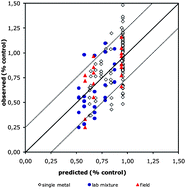A feeding inhibition based prediction of the toxic effect of dissolved metal mixtures upon Echinogammarus marinus (Crustacea: Amphipoda) at field relevant concentrations across a latitudinal gradient
Abstract
Risk assessment of metals in the environment is performed mainly with toxicity evaluations on single metals, which is largely inadequate since these substances occur in mixtures. The development of models predicting combined toxic effects on the basis of the concentration–response relationships of individual compounds has emerged as an answer. In the present study, metal effects on post-exposure anorexia (the concept of FdC50—concentration causing 50% of feeding inhibition—is implemented) in Echinogammarus marinus, a widely distributed gammarid amphipod, were assessed and compared with modelled ones obtained through the application of the concentration addition (CA) model, which represents a reasonable worst-case scenario for the risk assessment of metal mixtures. Data were validated using in situ experiments performed along a latitudinal gradient (Iceland, Scotland and Portugal) aiming at establishing a geographic profile of autochthonous population susceptibilities to metals. For all of the metals studied concentrations in the water column at exposure sites were in good agreement with feeding inhibition levels. Models gave low to relatively high percentage agreement between predictions and


 Please wait while we load your content...
Please wait while we load your content...